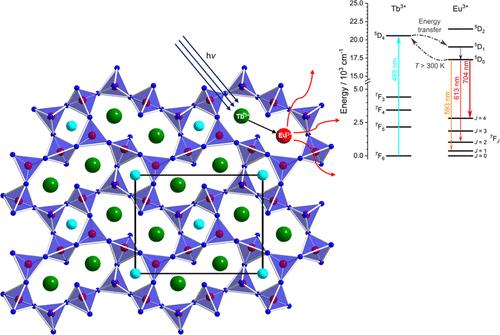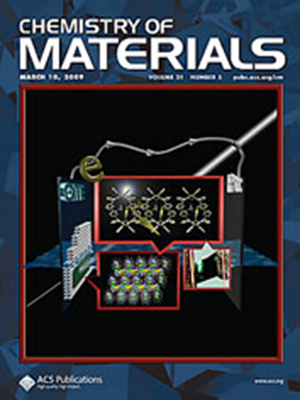具有类似钆石榴石晶体结构的镧系锌硼酸盐 Ln2Zn(B2O5)2(Ln = Eu、Tb、Yb、Lu)的高压/高温合成及 Tb2Zn(B2O5)2:Eu3+ 的发光特性
IF 7
2区 材料科学
Q2 CHEMISTRY, PHYSICAL
引用次数: 0
摘要
在改进的沃克型多钒装置中,通过高压/高温合成获得了四种新的镧系硼酸锌,其组成为 Ln2Zn(B2O5)2(Ln = Eu、Tb、Yb、Lu)。层状晶体结构由四元和八元的分角[BO4]四面体环组成。相邻的两层由以镧系元素和锌为中心的多面体连接。本文详细研究了 Eu3+ 激活的 Tb2Zn(B2O5)2 的发光特性和能量转移,并通过红外光谱和随温度变化的粉末 X 射线衍射对标题化合物进行了全面表征。结果表明,Tb3+ 和 Eu3+ 之间的能量转移效率极高(≥98%),这可能与该结构中约 3.45 Å 的异常短的镧系元素间距有关。这种发光温度计在室温以上具有相当高的相对灵敏度(在 425 K 时,Sr = 0.92% K-1),其使用可能依赖于从 Eu3+ 到 Tb3+ 的随温度变化的反向能量转移。本文章由计算机程序翻译,如有差异,请以英文原文为准。

High-Pressure/High-Temperature Synthesis of the Lanthanoid Zinc Borates Ln2Zn(B2O5)2 (Ln = Eu, Tb, Yb, Lu) with a Gadolinite-Analogue Crystal Structure and Luminescence Properties of Tb2Zn(B2O5)2:Eu3+
Four new lanthanoid zinc borates with the composition Ln2Zn(B2O5)2 (Ln = Eu, Tb, Yb, Lu) were obtained by high-pressure/high-temperature syntheses in a modified Walker-type multianvil device. The layered crystal structures are built up of four- and eight-membered rings of corner-sharing [BO4] tetrahedra. Two adjacent layers are linked by the lanthanoid- and zinc-centered polyhedra. A detailed investigation of the luminescence properties and energy transfer in Eu3+-activated Tb2Zn(B2O5)2 and a thorough characterization of the title compounds by infrared spectroscopy and temperature-dependent powder X-ray diffraction are provided. It turns out that the energy transfer between Tb3+ and Eu3+ is extremely efficient (≥98%), which can be related to the unusually short interlanthanoid distance of around 3.45 Å in this structure. The potential use as a lifetime-based luminescent thermometer relying on a temperature-dependent back energy transfer from Eu3+ to Tb3+ above room temperature with appreciable relative sensitivity (Sr = 0.92% K–1 at 425 K) is indicated.
求助全文
通过发布文献求助,成功后即可免费获取论文全文。
去求助
来源期刊

Chemistry of Materials
工程技术-材料科学:综合
CiteScore
14.10
自引率
5.80%
发文量
929
审稿时长
1.5 months
期刊介绍:
The journal Chemistry of Materials focuses on publishing original research at the intersection of materials science and chemistry. The studies published in the journal involve chemistry as a prominent component and explore topics such as the design, synthesis, characterization, processing, understanding, and application of functional or potentially functional materials. The journal covers various areas of interest, including inorganic and organic solid-state chemistry, nanomaterials, biomaterials, thin films and polymers, and composite/hybrid materials. The journal particularly seeks papers that highlight the creation or development of innovative materials with novel optical, electrical, magnetic, catalytic, or mechanical properties. It is essential that manuscripts on these topics have a primary focus on the chemistry of materials and represent a significant advancement compared to prior research. Before external reviews are sought, submitted manuscripts undergo a review process by a minimum of two editors to ensure their appropriateness for the journal and the presence of sufficient evidence of a significant advance that will be of broad interest to the materials chemistry community.
 求助内容:
求助内容: 应助结果提醒方式:
应助结果提醒方式:


